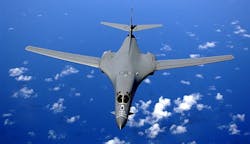B-1 bomber radar systems set for big technology upgrades with Northrop-Grumman SABR-GS
LINTHICUM, Md., 15 May 2015. The U.S. Air Force fleet of B-1B Lancer long-range jet bombers is on schedule to receive modern active electronically scanned array (AESA) radar, based on a new radar design by the Northrop Grumman Electronic Systems segment in Linthicum, Md.
Northrop Grumman has introduced its Scalable Agile Beam Radar-Global Strike (SABR-GS) for the B-1B fleet. The SABR-GS B-1 bomber radar is a multi-function AESA radar developed as an affordable, low risk radar retrofit for the B-1B bomber.
Large synthetic aperture radar maps, advanced image processing, and sensor integration provide a significant advantage in situational awareness and give the B-1 capabilities for intelligence, surveillance, reconnaissance, and targeting, Northrop Grumman officials say.
The radar system design is based on open-architecture standards to integrate data from other onboard sensors to facilitate life cycle maintainability and continued system upgrades.
SABR-GS is a derivative of the AN/APG-83 SABR that takes advantage of hardware, legacy modes, and advanced operating modes on the F-35, F-22, and F-16 jet fighter aircraft. Nearly three times the size of the F-16 SABR system, SABR-GS offers target area detail and digital maps under all weather conditions, company officials say.
Northrop Grumman developed the SABR-GS under a $21 million risk-reduction contract awarded in 2011 by the Air Force B-1 Systems Program Office. Northrop Grumman has flight-tested the advanced B-1 AESA and advanced sensor and fusion processing, readying the radar for engineering, manufacturing and development (EMD).
SABR-GS will replace the APQ-164 radar antenna deployed on all B-1 bombers. For more information contact Northrop Grumman Electronic Systems online at www.northropgrumman.com.

John Keller | Editor
John Keller is editor-in-chief of Military & Aerospace Electronics magazine, which provides extensive coverage and analysis of enabling electronic and optoelectronic technologies in military, space, and commercial aviation applications. A member of the Military & Aerospace Electronics staff since the magazine's founding in 1989, Mr. Keller took over as chief editor in 1995.



